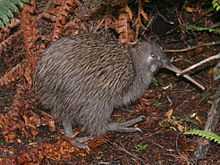Chatham kaka
| Chatham kaka | |
|---|---|
| Conservation status | |
| Extinct (between 1550–1700) | |
| Scientific classification | |
| Kingdom: | Animalia |
| Phylum: | Chordata |
| Class: | Aves |
| Order: | Psittaciformes |
| Superfamily: | Strigopoidea |
| Family: | Nestoridae |
| Genus: | Nestor |
| Species: | Nestor chathamensis |
The Chatham kaka or Chatham Island kākā (Nestor chathamensis) is an extinct parrot species previously found on the Chatham Islands, New Zealand.[1][2] The first individuals were thought to belong to the kākā (Nestor meridionalis), but detailed examination of the subfossil bones showed that they actually belong to a separate endemic species.[3] The species became extinct within the first 150 years of the arrival of the Polynesians around 1550, long before any European settlers.[3] No skins or descriptions are available.[3]
Taxonomy
The Chatham kaka is assigned to the genus Nestor in the family Nestoridae, a small group of parrot species native to New Zealand. It is considered to have been more closely related to the kākā (Nestor meridionalis) and the extinct Norfolk kaka (Nestor productus) than to the kea (Nestor notabilis).[3]
Ecology
The Chatham kaka was a forest dwelling species[3] of about the same size as the North Island subspecies of the kākā, Nestor meridionalis septentrionalis.[2] It had no natural predators (it was bigger than the kārearea, or New Zealand falcon) and, as is often observed with such island endemics, it is believed to have been a poor flyer.[3]
References
- ↑ Forbes, H. O. (1893). "A list of the birds inhabiting the Chatham Islands". Ibis 35 (4): 521–546. doi:10.1111/j.1474-919X.1893.tb01240.x.
- ↑ 2.0 2.1 Dawson, E. W. (1959). "The supposed occurrence of Kakapo, Kaka and Kea in the Chatham Islands". Notornis 8 (4): 106–114.
- ↑ 3.0 3.1 3.2 3.3 3.4 3.5 Millener, P. R. (1999). "The history of the Chatham Islands’ bird fauna of the last 7000 years – a chronicle of change and extinction. Proceedings of the 4th International meeting of the Society of Avian Paleontology and Evolution (Washington, D.C., June 1996)". Smithsonian Contributions to Paleobiology 89: 85–109.
| ||||||||||||||||||||||||||
